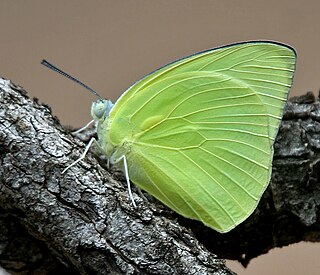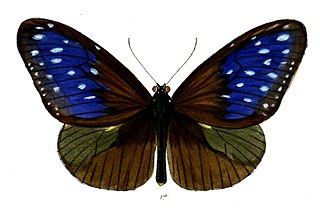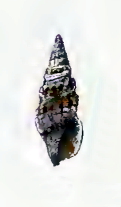Related Research Articles

Eurema hecabe, the common grass yellow, is a small pierid butterfly species found in Asia, Africa and Australia. They are found flying close to the ground and are found in open grass and scrub habitats. It is simply known as "the grass yellow" in parts of its range; the general term otherwise refers to the entire genus Eurema.

Catopsilia pomona, the common emigrant or lemon emigrant, is a medium-sized pierid butterfly found in Asia, Cambodia and parts of Australia. The species gets its name from its habit of migration. Some early authors considered them as two distinct species Catopsilia crocale and Catopsilia pomona.

Euploea mulciber, the striped blue crow, is a butterfly found in India and Southeast Asia that belongs to the crows and tigers, that is, the danaid group of the brush-footed butterflies family.

The northern olingo, also known as the bushy-tailed olingo or as simply the olingo, is a tree-dwelling member of the family Procyonidae, which also includes raccoons. It was the first species of olingo to be described, and while it is considered by some authors to be the only genuine olingo species, a recent review of the genus Bassaricyon has shown that there are a total of four olingo species, although two of the former species should now be considered as a part of this species. Its scientific name honors William More Gabb, who collected the first specimen. It is native to Central America.

Kaniska canace, the blue admiral, is a nymphalid butterfly, the only species of the genus Kaniska. It is found in south and southeast Asia.

Junonia almana, the peacock pansy, is a species of nymphalid butterfly found in Cambodia and South Asia. It exists in two distinct adult forms, which differ chiefly in the patterns on the underside of the wings; the dry-season form has few markings, while the wet-season form has additional eyespots and lines.It is listed as Least Concern in the IUCN Red List.

The big-headed pantanal swamp turtle or pantanal swamp turtle is a species of turtle in the family Chelidae found in Argentina, Bolivia, Brazil, and Paraguay.
Tessema sensilis is a little-known moth species, the only member of genus Tessema. It belongs to the grass moth family (Crambidae), and therein to the large subfamily Spilomelinae; at the time of its description, these were still included in subfamily Pyraustinae and the entire Crambidae was then merged with the snout moths. While its detailed relationships are undetermined, it may be a close relative of Herpetogramma and/or Pilocrocis.

Crassispira flavonodulosa is a species of sea snail, a marine gastropod mollusk in the family Pseudomelatomidae.

Durrell's vontsira is a Madagascan mammal in the family Eupleridae of the order Carnivora. It is most closely related to the brown-tailed mongoose, with which it forms the genus Salanoia. The two are genetically similar, but morphologically distinct, leading scientists to recognize them as separate species. After an individual was observed in 2004, the animal became known to science and S. durrelli was described as a new species in 2010. It is found only in the Lac Alaotra area.
Blennophis anguillaris, the snaky klipfish, is a species of clinid found in the subtropical waters of the Atlantic Ocean around South Africa. It can be found in the subtidal zone and also is a denizen of tidepools. This species can reach a maximum length of 30 centimetres (12 in) TL.
Cosmopterix clandestinella is a moth of the family Cosmopterigidae. It is known from the United States.
Cosmopterix euanthe is a moth of the family Cosmopterigidae. It is known from the Federal District of Brazil.
Cosmopterix lysithea is a moth of the family Cosmopterigidae. It is known from the Federal District of Brazil.
Cosmopterix nishidai is a moth of the family Cosmopterigidae. It is known from Costa Rica.

Pseudophilautus semiruber, known as Annandale's Shrub Frog, is a species of frog in the family Rhacophoridae that is endemic to Sri Lanka.

Raorchestes coonoorensis, also known as the Coonore bushfrog or Coonoor bush frog, is a species of frogs endemic to the Western Ghats, India. It is reported from its type locality, Sim's Park in Coonoor, with an additional observation from Kothagiri; both locations are in the state of Tamil Nadu. Its altitudinal range is 1,780–1,850 m (5,840–6,070 ft) asl.

Protopone is an extinct genus of ants in the formicid subfamily Ponerinae described from fossils found in Europe and Asia. There are seven described species placed into the genus, Protopone? dubia, Protopone germanica, Protopone magna, Protopone oculata, Protopone primigena, Protopone sepulta, and Protopone vetula. Protopone is one several Lutetian Ponerinae genera.
Ivondrovia is a genus of parasitoid wasps belonging to the subfamily Doryctinae of the family Braconidae. This genus contains two species. It is found in the Afrotropical region.
Ivondrovia seyrigi is a species of parasitoid wasp belonging to the subfamily Doryctinae of the family Braconidae. It is endemic to Madagascar.
References
- 1 2 Belokobylskij, S.; Zaldivar-Riveron, A.; Castañeda-Osorio, R. (2018). "Revision of the Afrotropical genus Ivondrovia Shenefelt & Marsh, 1976 with description of a new species". ZooKeys (747): 87–100. doi:10.3897/zookeys.747.24351. PMC 5904487 . PMID 29674905 . Retrieved 3 April 2018.
| This Ichneumonoidea-related article is a stub. You can help Wikipedia by expanding it. |